S.S.C. Bari
| Full name | Società Sportiva Calcio Bari S.S.D. a r.l. | |||
|---|---|---|---|---|
| Nickname(s) |
i Galletti (The Cockerels) i Biancorossi (The White-reds) | |||
| Founded |
15 January 1908 2014 (re-founded) 2018 (re-founded) | |||
| Ground | Stadio San Nicola | |||
| Capacity | 58,270 | |||
| Owner | Aurelio De Laurentiis | |||
| Chairman | Luigi De Laurentiis | |||
| Manager | Giovanni Cornacchini | |||
| League | Serie D | |||
| 2017–18 | Serie B, 7th | |||
| Website | Club website | |||
|
| ||||
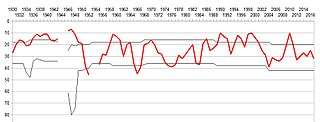
Società Sportiva Calcio Bari[1] is an Italian football club founded in 1908, they are based in Bari, Apulia and last played in Serie B. The club spent many seasons bouncing between the top two divisions in Italian football, Serie A and Serie B. From the 2018–19 season they will play in Serie D.[2]
History
Brief history
During 1927, the original football club representing the city was merged with a team named Liberty Bari, a year following this the new club was merged too, this time with US Ideale; hence the sometimes given foundation date of 1928.
Statistically Bari are the most successful club from the Apulia region, in terms of the all-time Serie A records. They are amongst the elite in Southern Italian football and are ranked 17th in the all-time Serie A records for all of Italy. Notably they won the Mitropa Cup in 1990. Bari also held the British football transfer record, when it paid £5,500,000 for David Platt in 1991. It was the most expensive fee paid by a foreign club for a British player for four years.
One of the most notable achievements in the club's history was in the 1996 season, when their forward Igor Protti became the top scorer in the Serie A with 24 goals. The club are known in the wider footballing world for producing Antonio Cassano who was born in Bari, he shone at the club as a youngster.
The foundation
Foot-Ball Club Bari was founded in the city on 15 January 1908.[3] Like the majority of early Italian football clubs, foreign people were involved in the foundation of the club. Amongst the main founders were German Floriano Ludwig, Swiss Gustavo Kuhn and a native trader of Bari called Giovanni Tiberini.[4]
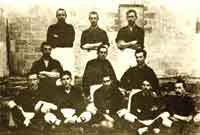
The first players included many non-Italians, the FBC Bari originals included; founder Ludwig, along with Barther (English), Bach (Swiss), Attoma, Roth (Swiss), Labourdette (Spanish), Jovinet (French), Giordano, Gazagne (French), Randi and Ziegler. Originally the club wore red shirts with white shorts, early on they would play against English sailors at the San Lorenzo field in the San Pasquale area of Bari.
Although the club was founded early on, clubs from the Mezzogiorno were not very well represented in the early Italian football championships and thus Bari did not take part in the early seasons. In fact only Campania had a regional section in the league from that area prior to the First World War. The war would see the original club becoming defunct, before being reorganised under the same name.
By this time other clubs from the city had begun playing too, including; Foot-Ball Club Liberty who originally wore blue and white stripes, they were founded as a dissident club from the original Bari in 1909[5] and their rivals Unione Sportiva Ideale who wore green and black stripes. In fact it was FBC Liberty who became the first ever side from the Province of Bari to take part in the Italian Football Championship, this was during the 1921–22 CCI season, when the main clubs in the country had a falling out with FIGC.
The following season Ideale became the first side from Bari to progress to the Southern Italian semi-finals round, but lost out to Lazio. All three clubs featured in the championship for the first time in 1924–25 however FBC Bari were relegated, Liberty on the other hand reached the Southern semi-finals before losing out heavily to Alba Roma.
Unione Sportiva Bari
A series of club mergers took place in the city over the course of two years, which would create one united club to represent Bari. The first merger took place between FBC Bari and FBC Liberty, they opted to keep the Bari name and first used it on 6 February 1927 in a match against Audace Taranto.
The whole of Italian football was changing during this period and beginning to become more organised, similar mergers were taking place in Naples, Florence and Rome around the same time. The second part of the Bari merger was competed on 27 February 1928 when FBC Bari merged with US Ideale to create Unione Sportiva Bari. The original US Bari shirts incorporated the stripes of Ideale, with the red and white colours of FBC Bari.
After the Italian Championship of 1928–29, the league system was reorganised and Bari was placed in Serie B. One of their players was called up to the Italian national football team that season for the first time, in the form of Raffaele Costantino, this made Bari the first Serie B club to contribute a player and a scorer to the national side.[6]
Between Serie A and Serie B

The 1930s and 1940s were Bari's golden age, spending much of that time in Serie A with a finish of seventh in 1947 being the best they achieved.
In the 1950s Bari went into a sharp decline and an equally rapid revival towards the end of the decade to spend three more years in Serie A (1958–61). Stars of the team in this period included Biagio Catalano and Raúl Conti. The club returned to Serie A twice more in this period (1963–64 and 1969–70) with the latter proving especially harrowing with only 11 goals scored, the lowest of any top-flight club. In 1974 Bari descended to Serie C, finishing that season with only 12 goals scored and 26 conceded in 38 games.
By the late 1970s Bari were back in Serie B and on something of an upward swing, narrowly missing promotion in 1982. They managed promotion to Serie A in 1985 and acquired English players Gordon Cowans and Paul Rideout, but they were unable to prevent an instant return to Serie B. A return to Serie A in 1989 with stars including stalwart defender Giovanni Loseto, midfielder Pietro Maiellaro and Brazilian striker João Paulo saw a respectable 10th-place finish in 1990, their last season at the Della Vittoria. The following season saw Bari move to the San Nicola stadium, built for the 1990 World Cup, but by 1992, despite the signing of David Platt, they would be relegated once more.
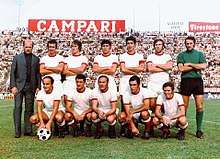
Promotion in 1994 saw another two-year stay in Serie A with Igor Protti a regular scorer, and another promotion in 1997 saw the emergence of promising youngsters like Nicola Ventola, Gianluca Zambrotta, Antonio Cassano and Diego De Ascentis. This time they managed a four-year stay in Serie A under the guidance of Eugenio Fascetti, despite his uneasy relationship with many sections of the club's support. The club has since had a generally indifferent spell in Serie B. However, having been near the top of the Serie B table for much of the 2008–09 season they gained promotion to Serie A on 8 May 2009, under the guidance of Antonio Conte.
In November 2009, a take-over bid was rejected.[7] A Texas-based company JMJ Holdings also gave an intent to take over in August 2009.[8][9]
With Leonardo Bonucci and Andrea Ranocchia as centre-back and Barreto as striker, Bari performed well in the first half of the season. Eventually Bari finished 10th. However, Bari lost €19 million in 2009 financial year,[10] which meant Bari was quiet in the 2010 summer window (only Almirón and Ghezzal were the new significant signings plus the purchase of Barreto after the expiration of his loan, who broke his leg in mid-season) and in the January 2011 transfer window, they failed to find a replacement of Bonucci and Ranocchia. The company recovered from negative equity due to TV income increasing as well as the sale of Bonucci (a profit of €6.45 million). Bari had a positive equity of €870,653 on 31 December 2010 and a net income of 14 million in the 2010 calendar year, due to extraordinary income from selling the brand.[11]
.svg.png)
Bari were relegated to Serie B after the 2010–11 season finishing 17 points short of 17th placed Lecce. During the season, manager Giampiero Ventura was replaced by Bortolo Mutti in a failed attempt to save the club from relegation. On the 4th of March, 2011, Bari played its 1,000th game in Serie A.
The End of the Matarrese reign
On the 13th of June, 2011, President Vincenzo Matarrese and the rest of the board of directors resigned after 28 years of controlling the club. Vincenzo Torrente was brought in to manage the side in the summer of 2011 and much of the playing roster was let go due to financial difficulties at the club and replaced by young players. Despite six and seven point penalties in the following two seasons, Bari under Torrente were able to achieve to mid-table Serie B finishes however, disconcertingly, attendances continued to dwindle. In the summer of 2013, Torrente resigned and was replaced by Carmine Gautieri, who also resigned after two weeks. The top job was then assigned to Roberto Alberti Mazzaferro.
The financial position of the club continued to decline and the Mattarese family reduced the amount of money they put into the club. The club's debt reached €30m in February 2014. The club was declared bankrupt on March 10, 2014. The first bankruptcy auction, on the 18th of April 2014, was declared deserted due to the lack of a bid that met all of the criterion. The second auction, on 12 May 2014, also failed to find a successful bidder. The club was in real danger of disappearing.
F.C. Bari 1908
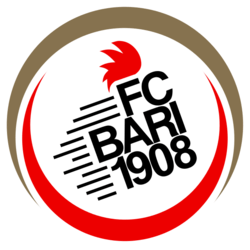
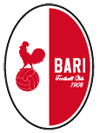
The third bankruptcy auction was held on the 20 May 2014 with an asking price for the club of just €2m. A consortium F.C. Bari 1908 S.p.A. led by former Serie A referee Gianluca Paparesta successfully acquired the club assets and sports title. A strong spell of form towards the end of the season, where the club lost just two of its last 15 Serie B matches, meant that Bari qualified for the 2013–14 Serie B play-offs. Bari met Crotone in the quarter finals and won 3–0, setting up a clash against Latina, the side that finished 3rd in the regular season. The first leg of the play-off semifinal was a sell out with over 50,000 people attending the match, an incredible achievement considering the club recorded an attendance of less than 1,000 just a few months earlier. Bari were knocked out due to two draws (2–2 and 2–2).
In 2014–15 the team ended the season in 10th place. In 2015–16 Bari gained 5th place in the league and subsequent access to the play-off preliminary match against Novara but lost 4–5 after extra time at Stadio San Nicola.
In December 2015, Cosmo Giancaspro acquired 5% shares of Bari [12] of the club. In April 2016 Noordin Ahmad signed a preliminary agreement to acquire 50% shares of the club[13][14] but the deal collapsed; In June 2016 Cosmo Giancaspro became the sole director (Italian: Amministratore Unico) of the club, after the entire share capital were acquired by an Italian company Kreare Impresa S.r.l..[15] According to La Repubblica, Kreare Impresa was owned by Giancaspro, but both Giancaspro and his company was involved in a money laundering investigation.[16]
A new beginning from Serie D: SSC Bari
On 16 July 2018, Bari were excluded by Co.Vi.Soc. from participating in 2018–19 Serie B due to financial reasons.[17] The shareholders also tried to recapitalize the club[18] and appeal the exclusion to Collegio di Garanzia of Italian National Olympic Committee (CONI), however, it was rejected.[19]
Thanks to the Article 52 of N.O.I.F., it was reported that Aurelio De Laurentiis, the owner of football club Napoli and film company Filmauro, had won the rights to establish a phoenix club of Bari and re-start in 2018–19 Serie D.[20] He also re-established the current Napoli in 2004. The new club will be named S.S.C. Bari, with De Laurentiis stating his intention to bring it back to Serie A as fast as possible.[1] The club was subsequently assigned to Group I of 2018–19 Serie D, traditionally destined to teams from Sicily and Calabria.[21]
On 23 August 2018, as part of a press conference, Aurelio De Laurentiis announced his eldest son, film producer Luigi De Laurentiis Jr.,[22] as the new Bari chairman.[23]
Sponsors
| Period | Kit manufacturer | Shirt sponsor |
|---|---|---|
| 1978–1979 | Puma | None |
| 1980–1981 | Pouchain | None |
| 1981–1984 | Adidas | MAN SE |
| 1984–1987 | Cassa di Puglia | |
| 1987–1990 | Sud Leasing | |
| 1990–1992 | Sud Factoring | |
| 1992–1995 | Wuber | |
| 1995–1997 | CEPU | |
| 1997–1998 | Lotto | Transport Gio.Bi |
| 1998–2003 | TELE + | |
| 2003–2005 | Pasta Ambra | |
| 2005–2006 | Erreà | |
| 2006–2009 | Gaudianello | |
| 2009 | Radionorba | |
| 2009–2012 | Banca Popolare di Bari | |
| 2012–2013 | Fashion District | |
| 2013–2015 | SuisseGas | |
| 2015–2016 | Nike | Balkan Express |
| 2016–2017 | Umbro | Betaland |
| 2017–2018 | Zeus Sport[24] | Peroni 3.5 |
| 2018–present | Kappa |
Presidential history
The official presidential history of Bari, since 1929 until the present day.
|
|
Managerial history
Bari have had many managers and trainers, some seasons they have had co-managers running the team, here is a chronological list of them from 1928 onwards:[25]
- Egri Erbstein (1928–29)
- Josef Uridil (1929–30)
- János Hajdu (1930–31)
- Árpád Weisz (1931–32)
- Egri Erbstein, Lászlo Barr (1932–33)
- Tony Cargnelli (1933–34)
- Engelbert König (1934–35)
- András Kuttik (1935–36)
- Tony Cargnelli (1936–38)
- József Ging (1938–39)
- András Kuttik (1939)
- Raffaele Costantino (1939–40)
- Luigi Ferrero (1940–41)
- András Kuttik (1941)
- Raffaele Costantino (1941)
- Stanislao Klein (1941–42)
- Raffaele Costantino (1942–43)
- János Vanicsek (1943)
- Raffaele Costantino (1944–45)
- András Kuttik (1946)
- Raffaele Costantino (1946–47)
- János Nehadoma (1947)
- András Kuttik (1947–48)
- Ferenc Plemich (1948)
- András Kuttik (1948)
- Raffaele Costantino (1948–49)
- Ferenc Plemich (1949)
- György Sárosi, Francesco Capocasale (1949–50)
- Raffaele Costantino (1950)
- Francesco Capocasale (1950)
- Federico Allasio (1950)
- Ambrogio Alfonso (1950–51)
- Mario Sandron (1951)
- Paolo Giammarco (1951)
- Pietro Piselli (1951)
- Raffaele Costantino (1951–52)
- Vincenzo Marsico (1952)
- Raffaele Sansone (1952–53)
- Francesco Capocasale (1953–56)
- Federico Allasio (1956–58)
- Paolo Tabanelli (1958–59)
- Francesco Capocasale (1959–61)
- Onofrio Fusco (1961)
- Luis Carniglia (1961)
- Federico Allasio (1961–62)
- Onofrio Fusco (1962)
- Pietro Magni (1962–63)
- Tommaso Maestrelli (1963–64)
- Paolo Tabanelli (1964)
- Francesco Capocasale (1964–65)
- Onofrio Fusco (1965)
- Hugo Lamanna (1965–66)
- Filippo Calabrese (1966)
- Lauro Toneatto (1966–69)
- Oronzo Pugliese (1969–70)
- Carlo Matteucci (1970)
- Lauro Toneatto (1970–72)
- Carlo Regalia (1972–74)
- Luciano Pirazzini (1974–75)
- Gianni Seghedoni (1975–76)
- Giuseppe Pozzo (1976)
- Giacomo Losi (1976–78)
- Mario Santececca (1978–79)
- Giulio Corsini (1979)
- Enrico Catuzzi (1979)
- Antonio Renna (1979–81)
- Enrico Catuzzi (1981–83)
- Luigi Radice (1983)
- Bruno Bolchi (1983–86)
- Enrico Catuzzi (1986–88)
- Gaetano Salvemini (1988–92)
- Zbigniew Boniek (1992)
- Sebastião Lazaroni (1992–93)
- Giuseppe Materazzi (1993–96)
- Eugenio Fascetti (1996–00)
- Arcangelo Sciannimanico (2001–02)
- Attilio Perotti (2002–03)
- Marco Tardelli (2003–04)
- Giuseppe Pillon (2004)
- Guido Carboni (2004–06)
- Rolando Maran (2006)
- Giuseppe Materazzi (2006–07)
- Antonio Conte (2007–09)
- Giampiero Ventura (2009–11)
- Bortolo Mutti (2011)
- Vincenzo Torrente (2011–13)
- Roberto Alberti Mazzaferro (2013–14)
- Devis Mangia (2014)
- Davide Nicola (2014–15)
- Andrea Camplone (2015–16)
- Roberto Stellone (2016)
- Stefano Colantuono (2016–17)
- Fabio Grosso (2017–18)
- Giovanni Cornacchini (2018–)
Honours
Serie B: 4
- Champions: 1934–35, 1941–42, 1945–46 (Serie A-B Southern Italy co-champions with Napoli), 2008–09
- Runners-up: 1930–31, 1933–34 (without promotion), 1957–58, 1962–63, 1988–89, 1993–94
- Other Promotions: 1927–28, 1968–69, 1984–85, 1996–97
Mitropa Cup: 1
- Winners: 1990
See also
References
- 1 2 "Il calcio a Bari ripartirà ufficialmente con Aurelio De Laurentiis" (in Italian). Fox Sports. 31 July 2018. Retrieved 13 August 2018.
- ↑ "Bari to restart in Serie D". Football Italia. Retrieved 17 July 2018.
- ↑ AmoBari.org Archived 7 May 2009 at the Wayback Machine.
- ↑ In Internet
- ↑ Repubblica.it Archived 18 November 2007 at the Wayback Machine.
- ↑ Forza Azzurri – Bari
- ↑ "RIFIUTATA L'OFFERTA MELEAM PER L'ACQUISTO DELLA AS BARI SPA". AS Bari (Press release) (in Italian). 27 November 2009. Archived from the original on 26 October 2010. Retrieved 14 March 2011.
- ↑ "JMJ Holdings announces intent to purchase AS Bari football team". AS Bari (Press release) (in Italian). 18 August 2009. Archived from the original on 26 October 2010. Retrieved 14 March 2011.
- ↑ "L'Ad Salvatore Matarrese: 'Oggi scadenza improrogabile". AS Bari (Press release) (in Italian). 20 September 2009. Archived from the original on 2 October 2009. Retrieved 14 March 2011.
- ↑ "Assemblea dei soci: approvato il bilancio della Società". AS Bari (in Italian). 28 May 2010. Retrieved 14 March 2011.
- ↑ AS Bari Report and Accounts on 31 December 2010 (in Italian)
- ↑ "Cambio di assetto societario: il 5% a Cosmo Giancaspro" (Press release) (in Italian). F.C. Bari 1908. 15 December 2015. Retrieved 20 January 2018.
- ↑ "Noordin Ahmad: Malaysia's mystery man at Bari". FourFourTwo. 2016-04-20. Retrieved 2017-08-31.
- ↑ "[no title]" (Press release) (in Italian). F.C. Bari 1908. 11 April 2016. Retrieved 19 November 2017.
- ↑ "Cosmo Antonio Giancaspro Amministratore Unico della FC Bari 1908" (Press release) (in Italian). F.C. Bari 1908. 23 June 2016. Retrieved 19 July 2018.
- ↑ Chiarelli, Mara (21 January 2018). "Soldi e crac, le manovre di Giancaspro". La Repubblica (in Italian). Rome: GEDI Gruppo Editoriale. ISSN 2499-0817. Retrieved 19 July 2018.
- ↑ Russi, Francesca (16 July 2018). "Bari, salta l'iscrizione al campionato in B: addio al calcio professionistico dopo 110 anni". La Repubblica (Bari edition) (in Italian). GEDI Gruppo Editoriale. Retrieved 19 July 2018.
- ↑ "Errata corrige del Comunicato pubblicato stamattina alle ore 8.00" (Press release) (in Italian). F.C. Bari 1908. 12 July 2018. Retrieved 15 July 2018.
- ↑ "Sezioni Unite: decisione rinviata su istanza cautelare per Commissariamento FIGC" (Press release) (in Italian). Italian National Olympic Committee. 31 July 2018. Retrieved 1 August 2018.
- ↑ "Il Bari è di De Laurentiis! Riparte con lui dalla Serie D". La Gazzetta dello Sport (in Italian). Milan: RCS MediaGroup. 31 July 2018. Retrieved 1 August 2018.
- ↑ "Gironi 2018/2019" (Press release) (in Italian). Lega Nazionale Dilettanti. 30 August 2018. Retrieved 31 August 2018.
- ↑ "Luigi De Laurentiis Jr". IMDB.com. Retrieved 31 August 2018.
- ↑ "Luigi De Laurentiis, un innovatore a Bari" (in Italian). 23 August 2018. Retrieved 31 August 2018.
- ↑ "Sponsor tecnico: accordo biennale con Zeus Sport" (Press release) (in Italian). F.C. Bari 1908. 26 June 2017. Retrieved 11 July 2017.
- ↑ "Gli Allenatori Del Bari Dal 1928". SoloBari.it. 24 Jun 2007.
External links
| Wikimedia Commons has media related to FC Bari 1908. |
- Official website (in Italian)